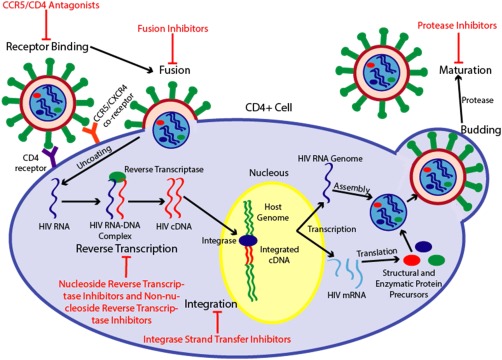Figure 1.

Depiction of the HIV life cycle and the mechanisms of action of the six classes of antiretroviral therapeutics. Mature HIV particles bind with CD4 receptors and either a CCR5 or CXCR4 co‐receptor, triggering a conformational change in the gp41 portion of the HIV env protein that enables fusion of the viral and cellular membranes. CCR5 and CD4 antagonists competitively bind with the host cell receptors, preventing viral binding and subsequent entry. Fusion inhibitors bind with gp41, preventing the conformational change needed for cellular entry. Once the viral membrane has fused with the cellular membrane, viral RNA and enzymes are released into the CD4+ cell, where viral reverse transcriptase transcribes the viral RNA into double‐stranded HIV cDNA. Nucleoside reverse transcriptase inhibitors competitively bind with reverse transcriptase and are incorporated into the DNA strand in place of native nucleotides, resulting in chain termination. Non‐nucleoside reverse transcriptase inhibitors non‐competitively bind with a distal hydrophobic pocket in HIV‐1 reverse transcriptase, inducing a conformation change that drastically reduces enzyme activity. The fully synthesized cDNA is incorporated into the host genome by viral integrase, a process that integrase strand transfer inhibitors impede by preventing the formation of covalent bonds between host and viral DNA. Once incorporated into the genome, normal cellular pathways transcribe the cDNA into a full length viral RNA genome and HIV mRNA strands that are translated into precursors of structural and enzymatic viral proteins. The precursor proteins and HIV RNA genome assemble into a viral capsid that buds from the cell, triggering viral protease to cleave the precursor peptides, resulting in full maturation of the viral particle. Protease inhibitors prevent this proteolytic cleavage, which is necessary for the complete development of the viral particle into a mature infectious agent.
